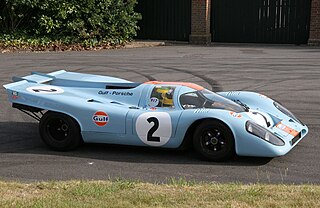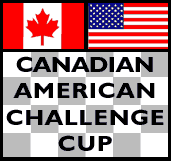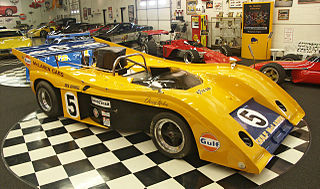Interserie is the name of a European-based motorsport series started in 1970 that allows for a wide variety of racing cars from various eras and series to compete with less limited rules than in other series.
Created in 1970 by German Gerhard Härle, it is inspired by English races of the 1960s for Group 7 machinery and by the Nordic Challenge Cup which had run in 1969 in Finland and Sweden. Initially using the Group 7 formula similar to that used by Can-Am in North America, the series would evolve to include open-wheel cars with sports-car style full bodywork from CART, Formula One, Formula 3000, Formula 3 and various other series, as well as Group C sports cars.
Although the teams are not as limitless in their modifications or powerplants, the series continues to run today, mostly with various open-wheel cars without full bodywork that became obsolete in current championship series.
Starting from 1999, the Interserie lost its international status and became a Central European championship with sprint races organised by the Automobilclub von Deutschland, mostly for modified formula cars.

Auto racing is a motorsport involving the racing of automobiles for competition.

Stock car racing is a form of automobile racing run on oval tracks and road courses measuring approximately 0.25 to 2.66 miles. It originally used production-model cars, hence the name "stock car", but is now run using cars specifically built for racing. It originates from the United States and Canada; the world's largest governing body is the American NASCAR. Its NASCAR Cup Series is the premier top-level series of professional stock car racing. Australia, New Zealand, Mexico, Brazil and the United Kingdom also have forms of stock car racing. Top-level races typically range between 200 and 600 miles in length.

Sports car racing is a form of motorsport road racing which utilises sports cars that have two seats and enclosed wheels. They may be purpose-built prototypes or grand tourers based on road-going models. Broadly speaking, sports car racing is one of the main types of circuit auto racing, alongside open-wheel single-seater racing, touring car racing and stock car racing. Sports car races are often, though not always, endurance races that are run over relatively large distances, and there is usually a larger emphasis placed on the reliability and efficiency of the car as opposed to outright speed of the driver. The FIA World Endurance Championship is an example of a sports car racing series.

Motorsport, motorsports or motor sport is a global term used to encompass the group of competitive sporting events which primarily involve the use of motorized vehicles. The terminology can also be used to describe forms of competition of two-wheeled motorised vehicles under the banner of motorcycle racing, and includes off-road racing such as motocross.
Lola Cars International Ltd. was a British race car engineering company in operation from 1958 to 2012. The company was founded by Eric Broadley in Bromley, England, before moving to new premises in Slough, Buckinghamshire and finally Huntingdon, Cambridgeshire, and endured for more than fifty years to become one of the oldest and largest manufacturers of racing cars in the world. Lola Cars started by building small front-engined sports cars, and branched out into Formula Junior cars before diversifying into a wider range of sporting vehicles. Lola was acquired by Martin Birrane in 1998 after the unsuccessful MasterCard Lola attempt at Formula One.

The Porsche 917 is a sports prototype race car developed by German manufacturer Porsche. The 917 gave Porsche its first overall wins at the 24 Hours of Le Mans in 1970 and 1971. Powered by the Type 912 flat-12 engine of 4.5, 4.9, or 5 liters, the 917/30 Can-Am variant was capable of 0-62 mph (100 km/h) time of 2.3 seconds and 0–124 mph (200 km/h) in 5.3 seconds. The long tail Langheck version had a maximum measured top speed of 386 km/h (240 mph).

The Canadian-American Challenge Cup, or Can-Am, was an SCCA/CASC sports car racing series from 1966 to 1987.

American open-wheel car racing, also known as Indy car racing, is a category of professional automobile racing in the United States. As of 2022, the top-level American open-wheel racing championship is sanctioned by IndyCar.

Formula 5000 was an open wheel, single seater auto-racing formula that ran in different series in various regions around the world from 1968 to 1982. It was originally intended as a low-cost series aimed at open-wheel racing cars that no longer fit into any particular formula. The '5000' denomination comes from the maximum 5.0 litre engine capacity allowed in the cars, although many cars ran with smaller engines. Manufacturers included McLaren, Eagle, March, Lola, Lotus, Elfin, Matich and Chevron.

The Porsche 962 is a sports-prototype racing car built by Porsche as a replacement for the 956 and designed mainly to comply with IMSA's GTP regulations, although it would later compete in the European Group C formula as the 956 had. The 962 was introduced at the end of 1984, from which it quickly became successful through private owners while having a remarkably long-lived career, with some examples still proving competitive into the mid-1990s. The vehicle was later replaced by the Porsche WSC-95.
Nordic Challenge Cup (NCC) was the predecessor of the popular and long-running sports car racing series Interserie, which is known as the "European Can-Am" and still exists today. NCC consisted of only three races in 1969 and was replaced by Interserie in 1970. It is now mostly remembered for the large number of Formula One drivers competing in it. Among these drivers were Jochen Rindt, who won the F1 World Drivers' Championship posthumously in 1970, and Jackie Oliver. The series also launched the career of Leo Kinnunen who went on to win the World Sportscar Championship the next year.
Group 5 was an FIA motor racing classification which was applied to four distinct categories during the years 1966 to 1982. Initially Group 5 regulations defined a Special Touring Car category and from 1970 to 1971 the classification was applied to limited production Sports Cars restricted to 5 litre engine capacity. The Group 5 Sports Car category was redefined in 1972 to exclude the minimum production requirement and limit engine capacity to 3 litres. From 1976 to 1982 Group 5 was for Special Production Cars, a liberal silhouette formula based on homologated production vehicles.

The Kremer K8 Spyder, along with its predecessor, the K7 (1992–1993), were open-cockpit prototypes built by Kremer Racing for use in multiple sportscar series, such as the IMSA GT Championship, Interserie, and International Sports Racing Series. The cars shared many components from the retired Porsche 962 and would eventually go on to win the 24 Hours of Daytona and several championships.

Brun Motorsport GmbH was a Swiss auto racing team founded by driver Walter Brun in 1983. They competed as a Porsche privateer team in sports car racing for their entire existence, running in a multitude of international championships. They notably won the World Sportscar Championship in 1986 and later became a full-fledged chassis constructor. Brun was also briefly part of the EuroBrun Formula One team from 1988 to 1990. The team was eventually dissolved in 1992.
Dauer Sportwagen GmbH was a German automotive company founded by former racing driver Jochen Dauer in Nuremberg. Initially founded as Jochen Dauer Racing in 1987, the racing team had several years of participation in the German Supercup and European Interserie championships, as well as occasional runs in the World Sports-Prototype Championship and Camel GT Championships with the Porsche 962. Following the demise of sports prototype racing in the early 1990s, Dauer Racing GmbH was created to begin limited production of road cars, including a road-legal version of the 962, known as the Dauer 962 Le Mans, which later went on to win the 1994 24 Hours of Le Mans. Once changing to Dauer Sportwagen, the company sold a continuation of the Bugatti EB110. The company went bankrupt in 2008 and parts for the EB110 were transferred to Toscana-Motors GmbH.

The McLaren M12 was an open-cockpit racing car developed by Bruce McLaren Motor Racing in 1969, solely for the purpose of selling to customers in the Can-Am series. The M12 combined elements from two of McLaren's previous efforts, the M6 series and the M8 series.

The McLaren M20 was a sports prototype developed by McLaren for the 1972 season of the Canadian-American Challenge Cup. It served as a replacement for the team's M8Fs, but it later became the final Can-Am design created by McLaren before the team left the series after failing to secure the 1972 championship title. M20s continued to be entered by private teams until the Can-Am championship was canceled at the conclusion of the 1974 season. McLaren driver Denny Hulme won two races during the 1972 season while Scooter Patrick won a single event in 1974 with a privately entered M20.
Group 7 was a set of regulations for automobile racing created by the Commission Sportive Internationale (CSI), a division of the modern Fédération Internationale de l'Automobile.

Willibert "Willi" Kauhsen is a German former racing driver and racing team owner from Eschweiler in Aachen, Germany.

The March 802 was an open-wheel Formula 2 racing car chassis, designed, developed and built by British manufacturer March Engineering in 1980. The car's best result in Formula 2 racing was third in the 1980 championship season, with Teo Fabi scoring 3 wins with ICI Racing Team. It was mainly powered by the BMW M12/7, but also Hart 420R, which were both 2.0 L (120 cu in) four-cylinder engines. As with other models, it was decided to later decided to convert the car and chassis to a closed-wheel sports prototype, and was used in the revived American Can-Am series, between 1981 and 1984. It was also used in the similar European Interserie sports car racing series, where its best result was a 1st-place finish at Zeltweg in 1981, being driven by Walter Lechner.














